Reviewer's Note: The ICON Rogue 1 was purchased from hkequipment on eBay. It should be available at local distributors shortly.
Warning: Pic heavy!
ICON is a new name on the flashlight scene, but the source behind it is well known: a spin-off from Surefire, ICON will be supplying new entry-level consumer lights that run on standard batteries.
First out of the gate are the Rogues, straightforward two-stage lights that run on 1xAA and 2xAA. Designed by legendary Surefire designer Paul Kim, these lights feature an innovative circuit and unusual body build. Reviewed below is the 1xAA version, but many of the features are common to both.
A word up front: don't expect typical Surefire quality or level of support with these lights. :tinfoil: On the plus side, price will also be commensurate with their entry level status: I believe MSRP will be under $40 for the Rogue 1, although early limited release samples in Asia ran for typically ~$70.

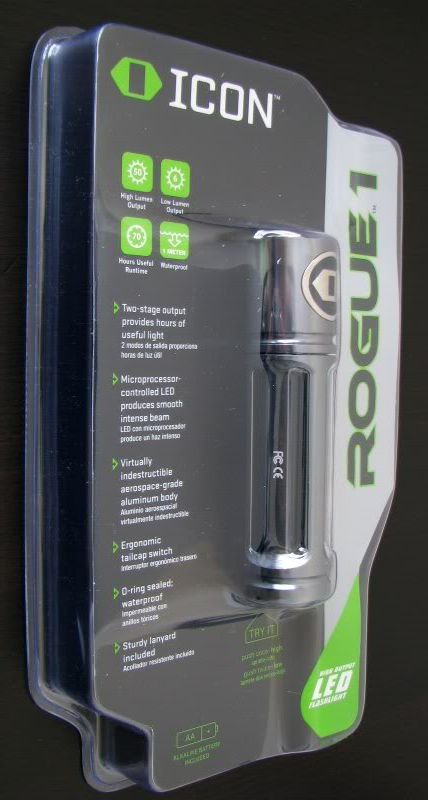
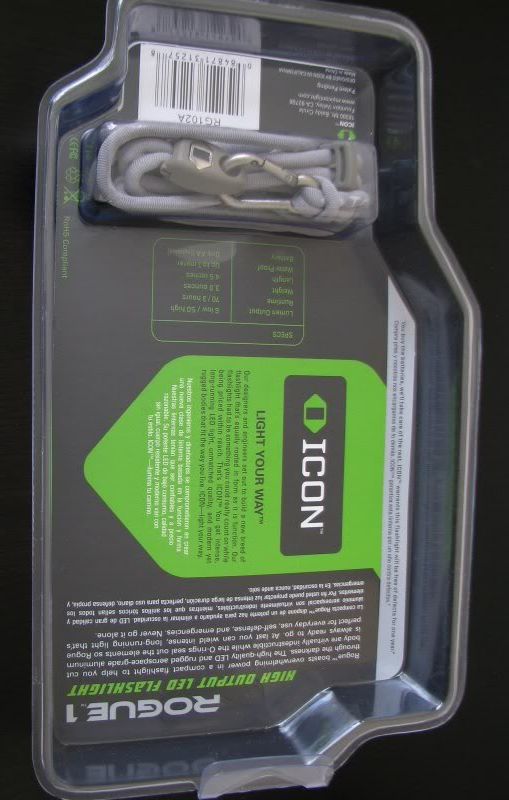
Certainly snazzy packaging. I opted for the gray model, but green and black are also available. As identified on the back, note that these are designed in the U.S. but made in China.
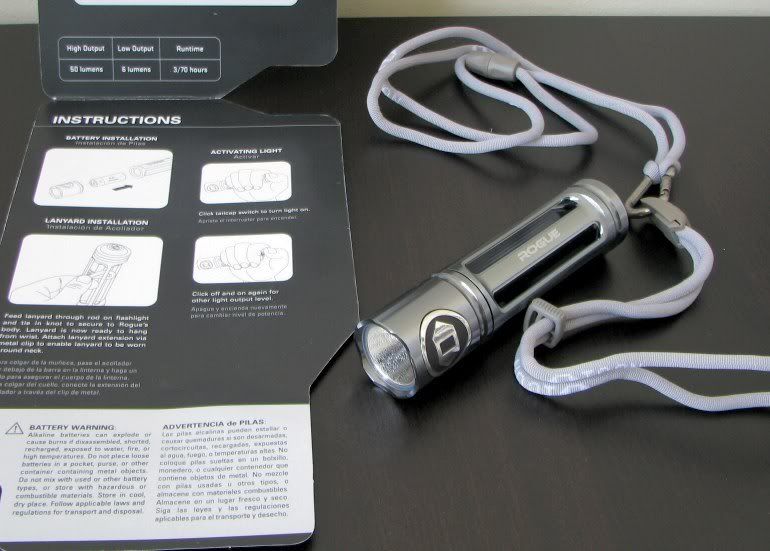
Inside you will find the light and very high quality wrist lanyard (with additional quick-release neck lanyard). :thumbsup: The instructions are included on the inside of the cardboard insert.
One thing that caught my eye – the warranty info for ICON is limited to a single year:
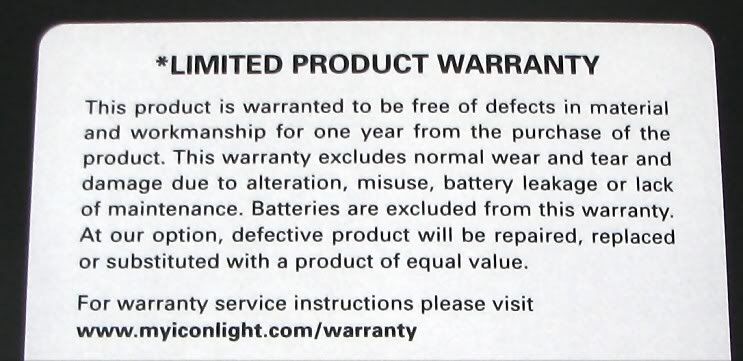
The light itself is most unusual. Much larger than typical 1xAA lights, the Rogue 1 has a unique look and design. Here is a size comparison to other 1xAA lights and a couple of classic Surefires:
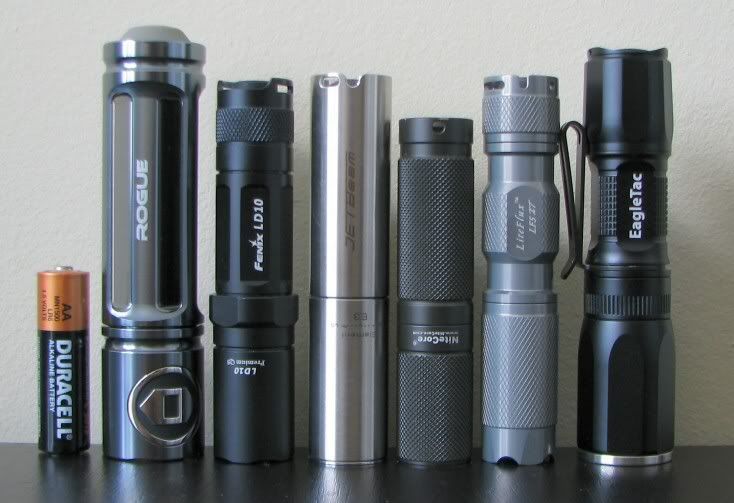
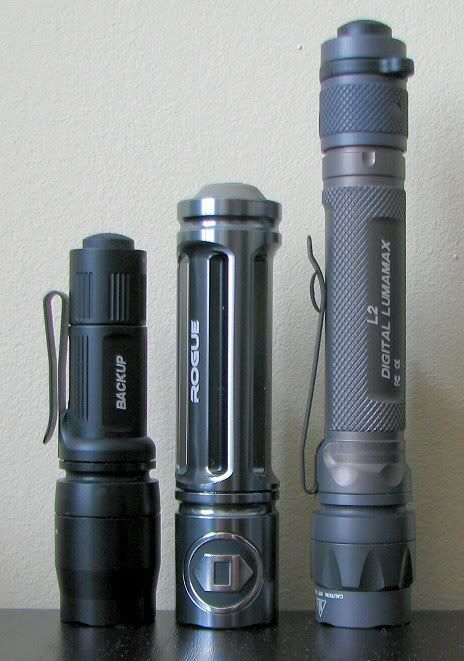
The light is not as heavy as you might think from first appearances, as three of the body tube flats are raised from the battery tube core.
Rogue 1 Weight: 85.6g
Rogue 1 Length: 114.0 mm
Rogue 1 Width: 27.7mm
For the record, most of the aluminium 1xAA lights shown above are in the 40-55g range, with the stainless steel lights in the 90-105g range.

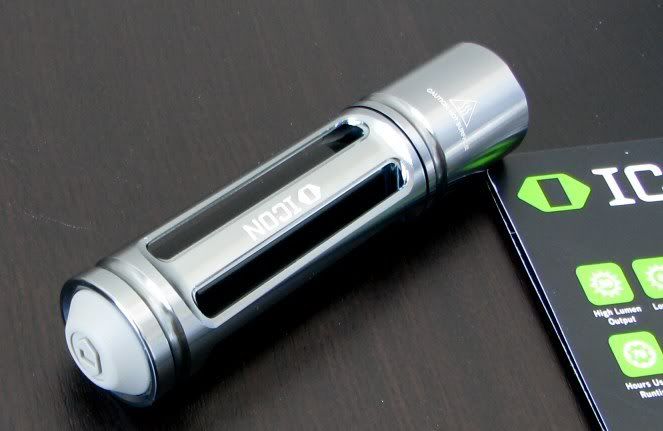
As an aside, when I first showed it to Mrs Selfbuilt, her initial impression was "wow, that's a solid looking light". When she went to pick it up, she was surprised by the relatively low weight for its apparent size – presumably explained by the hollow flats around the battery tube. Subsequent comments about those raised flats involved a few less-than-flattering references to potato peelers and cheese graters (rest assured they aren't that sharp).
EDIT: I may have to revise that statement - check out a little good natured ribbing in post #17.
Seriously, the raised flats do serve as a lanyard attachement point. There is no lanyard loop or ring. From the instructions:
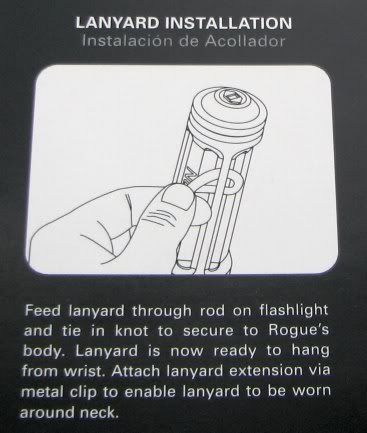
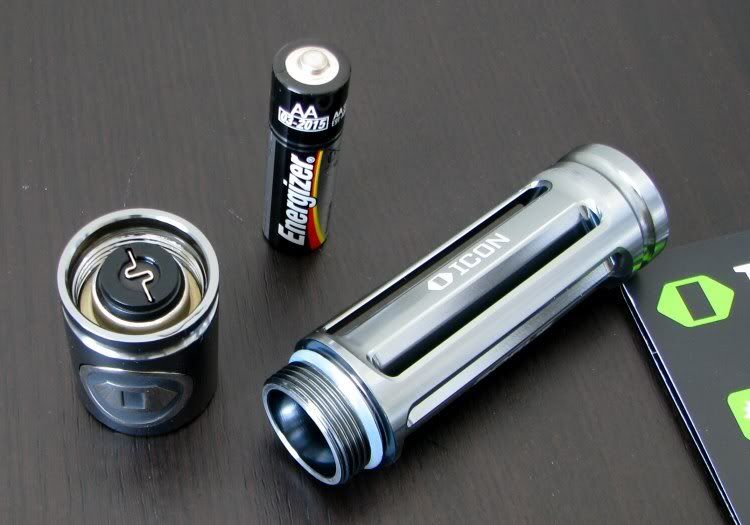
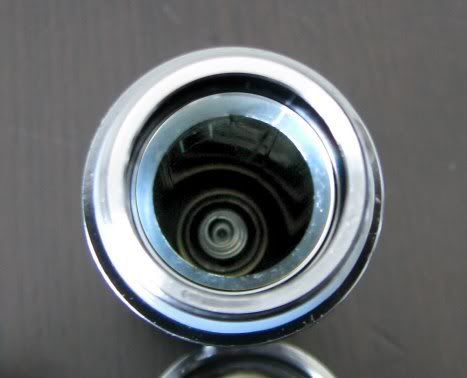
The head unscrews from the body tube, which is the only way to access the interior (the tailcap is continuous with the body tube, and is not obviously accessible). The light came with an Energizer AA battery inside, as shown. Screw threads are anodized, allowing for a head-body lockout. The overall mating appearance is similar to Surefire E-series lights, but of course these components are not E-series compatible.
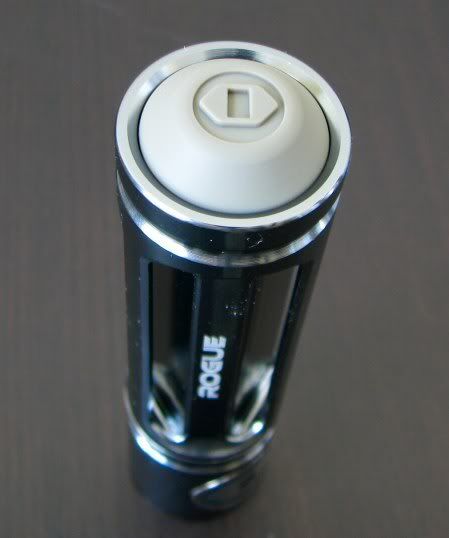
The tailcap is a forward clicky, with a large surrounding button cover. You can activate the light and switch modes in tactical momentary fashion. The light cannot tailstand.
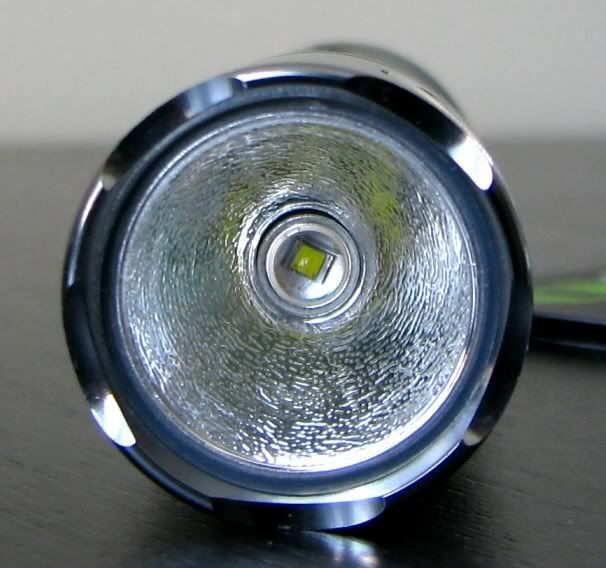
The head unit of this light is quite large by 1xAA standards. The light uses the common Cree Q5 emitter.
First thing you might notice is the rather heavy texturing to the OP reflector – this is much stronger than most other lights. A second point is that the emitter is clearly somewhat off-center on my sample. As you will see below, this doesn't cause a problem for the beam (likely due to the heavy reflector texturing).
A second point is that the emitter is clearly somewhat off-center on my sample. As you will see below, this doesn't cause a problem for the beam (likely due to the heavy reflector texturing).
I haven't opened the head up yet, but I believe both the reflector and lens are made of plastic. While this is bound to disappoint some, I've found in my testing that well-designed and well-made plastic reflectors can still perform just as well aluminium ones. :shrug: Scroll down for beamshots.
User Interface
The UI is in keeping with the KISS principle – click on once for Hi, click off and back on within a short period of time for Lo. Click again to turn off. Basically the same as the Surefire E1B Backup. :kiss:
Comparison Beamshots
All lights are on 100% on Sanyo Eneloop. Distance is about 0.5 meters from a white wall.
1/25sec, f3.2

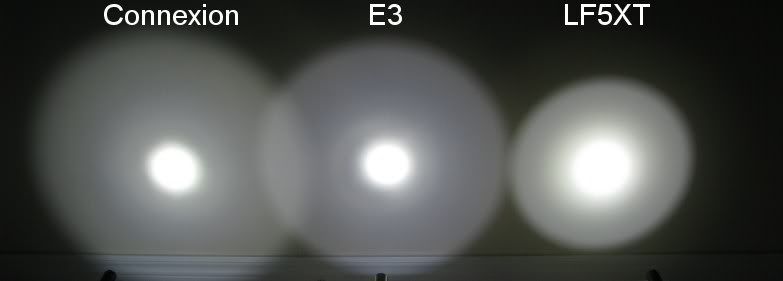
1/100sec, f3.2
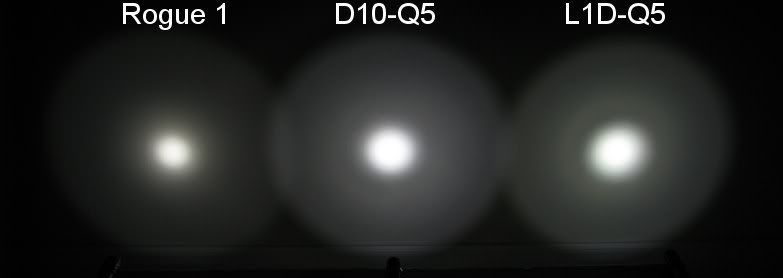
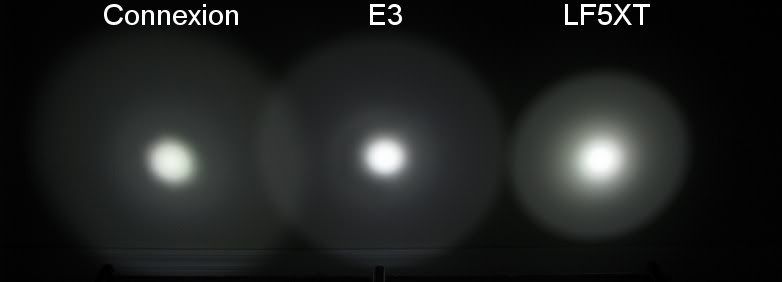
1/800sec, f3.2
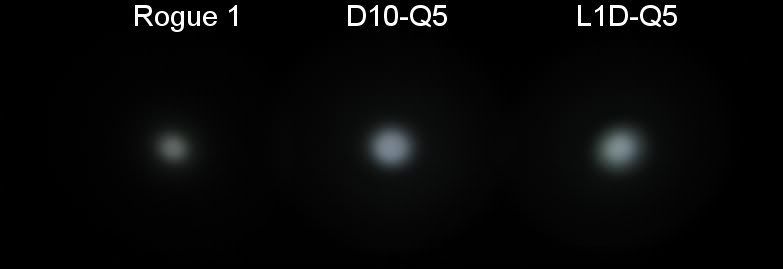
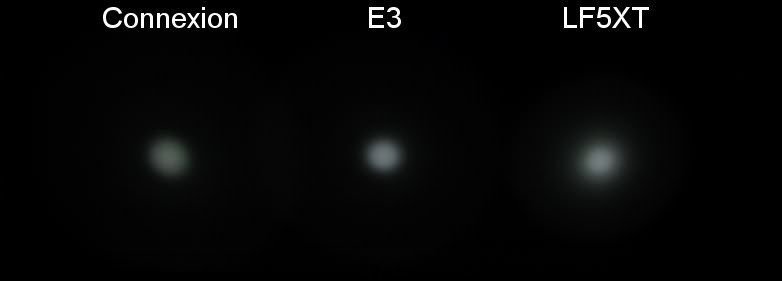
First thing you will note is the somewhat wider spillbeam compared to most lights. It is also clearly not much of a thrower.
But one thing I haven't heard in online discussions of this light is how pretty the beam looks – it's incredibly smooth and even, with a nice corona with little evidence of rings. :twothumbs Considering the mis-centered emitter on my sample, that's very impressive. Overall, I would say the beam is very SSC-like (reminds me a bit of my Novatac 120P). Tint is a pleasing slightly warm "cool white" on my sample.
Testing Method: All my output numbers are relative for my home-made light box setup, a la Quickbeam's flashlightreviews.com method. You can directly compare all my relative output values from different reviews - i.e. an output value of "10" in one graph is the same as "10" in another. All runtimes are done under a cooling fan..
Throw values are the square-root of lux measurements taken at 1 meter from the lens, using a light meter.
Throw/Output Summary Chart:

As you can see, the ICON Rogue does not have a strong initial output or throw on Hi on standard batteries. Until this light came out, the JetBeam E3P had the lowest Hi mode of any of my Cree Q5 lights. The Rogue 1 Lo mode is a very useful and respectable level – lower than the Fenix, but not ultra-low like the D10.
But this is just the tip of the iceberg – the real interest is in the runtime plots.
Output/Runtime Comparison:
To begin, here is a sample of what a "typical" well-regulated PWM-based light looks like on different battery types:
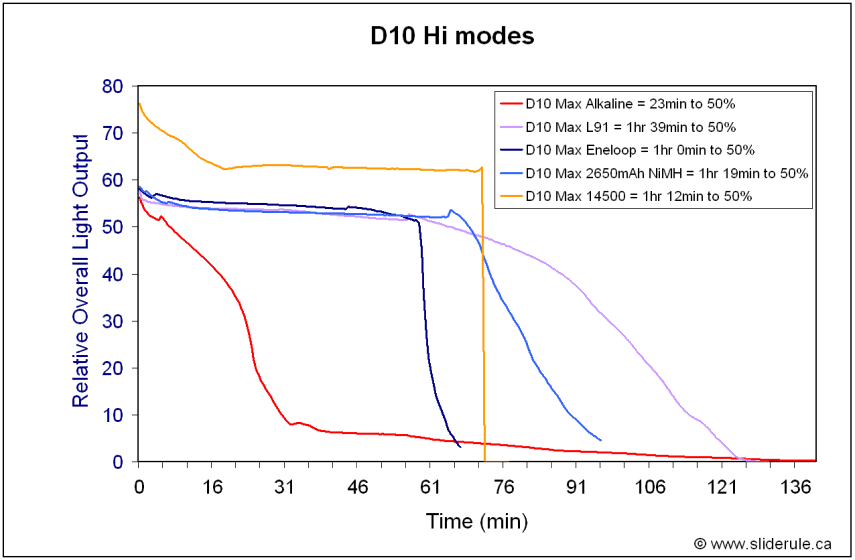
As you can see, Max output varies with battery type, as does the runtime pattern. This is consistent with being optimized for different battery chemistries. In general terms, most "regulated" lights that we are familiar with are regulated to as flat a level as possible, for as long as possible, on all supported battery sources.
Here's how the ICON Rogue 1 looks:
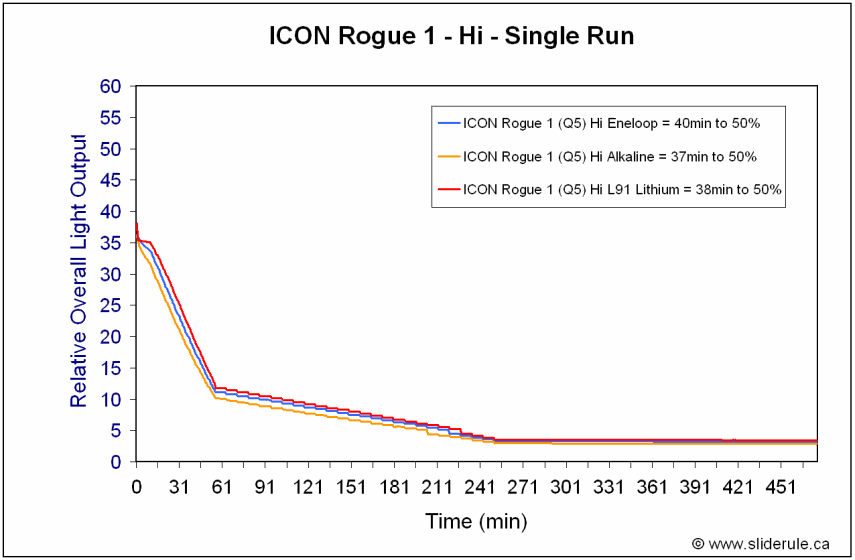
So what is going on here? :thinking: Basically, the Rogue regulates all battery types to the same general pattern and output on continuous running. Naturally, what will differ is how long the lights will run – that depends on the total capacity available in the battery.
This is quite novel in itself – but even more interesting is that actual pattern the lights are regulated to. The Rogue has 4 defined stages, each with its own characteristics. To illustrate how they work, here are some higher-resolution plots of the Stage 1-2 transition and Stage 2-3 transition time points:
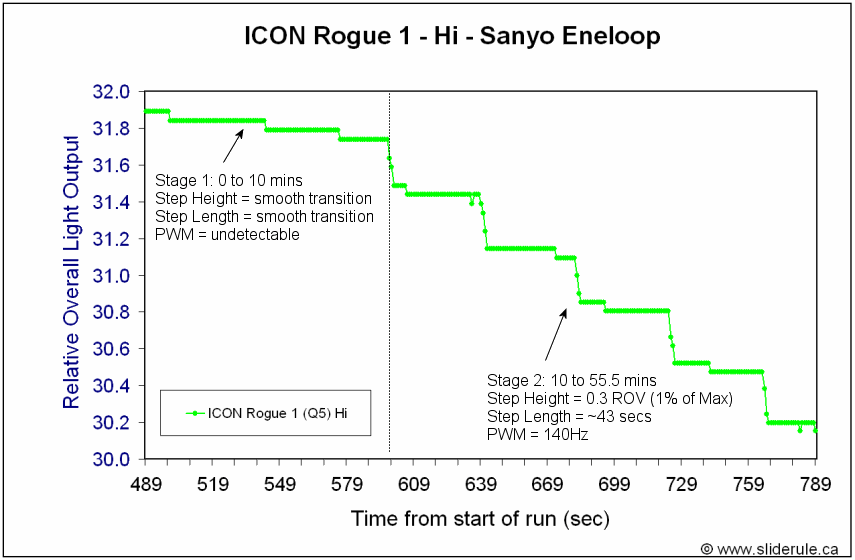
In Stage 1, the light runs on a fairly typical regulated pattern - relatively flat, but with a slow decay. This stage lasts for exactly 10mins of continuous running, with no perceptible PWM.
Stage 2 is a relatively rapid stepping down of output. At this point, PWM is detectable at a constant 140 Hz. Each step is almost exactly 0.3 on my relative output scale (ROV) - which given the initial output of just over 30 ROV, translates into a ~1% reduction. Each step lasts for ~43 secs. There are 65 such steps in this stage, thus taking an additional ~45.5 mins to complete.
Note that these steps remain visually-linear at 1% all along the way.

Stage 3 is a lengthening of the step interval time, with no change to the magnitude of the step down or the PWM frequency. The light is now at ~35% initial output, and continues to step down in ~1% visually-linear increments - but the duration of each step is increased to ~467 secs.
This stage continues for 25 such steps, thus taking an additional ~194.5 mins. Stage 4 is not shown, but this appears to be a gradual dimming of the light over long period of time, depending on the battery source. Relative light output at the start of Stage 4 is ~10% of maximum.
Whatever you may think of this pattern, it is a quite novel – to step-down in a visually-linear manner, with such tightly-controlled timings, is not something I've seen before. :thinking: I'll discuss the possible significance of this later in the review.
Note that you can return to start of the pattern by simply turning the light off and back on again. No lag time is needed – just off and on.
This is advantageous is real use – but also for my comparison purposes here. It is hard to compare this rapid drop-off pattern to other lights that use a more traditional burn-bright-until-dead approach to regulation. To get around this, I've decide to compare the runtimes of the Rogue with a repeated on/off switch at 1 hour intervals (to restore max output).
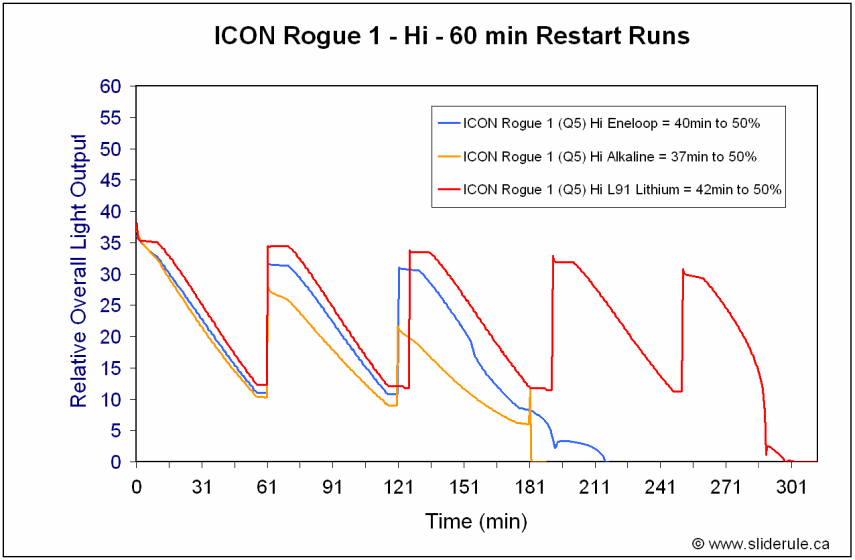
Now this is interesting. On NiMH or L91, the Rogue is able to pretty much directly repeat the initial output/runtime pattern upon restart. On alkaline, it still produces the same timings, but at a lower initial output.
What I found surprising here is that 2000mAh rated Eneloops do not appear to produce significantly more overall output/runtime than a standard alkaline cell. :huh: Typically, NiMH is much closer to L91 lithiums in terms of storage capacity and output/runtime ability. Based on these early results, it appears that the Rogue is probably designed for best efficiency on primary cells (alkaline and L91) rather than NiMH.
So how does this compare to the competition?
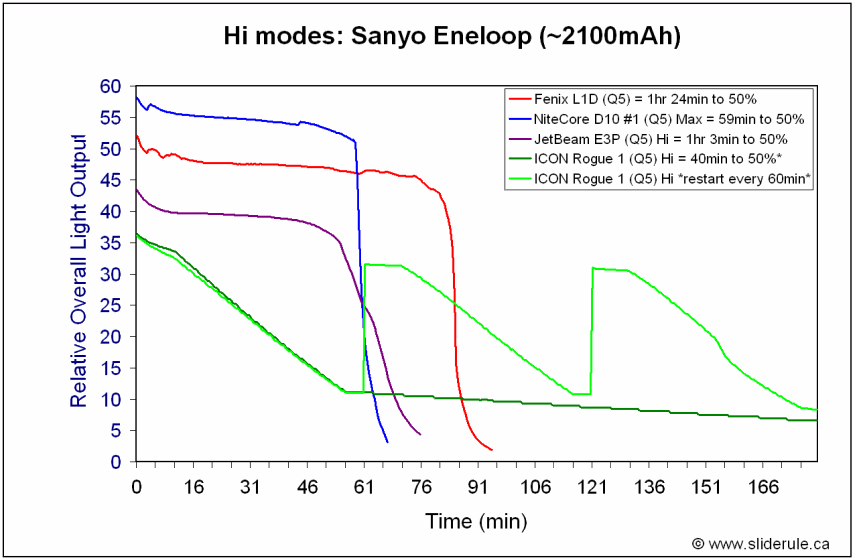
Obviously, the L1D and D10 are capable of much brighter max output. So this comparison doesn't tell us much - remember, lights are more efficient at lower drive currents. As such, I think comparing the Rogue 1 to L1D/D10 on Medium/50% modes makes more sense:
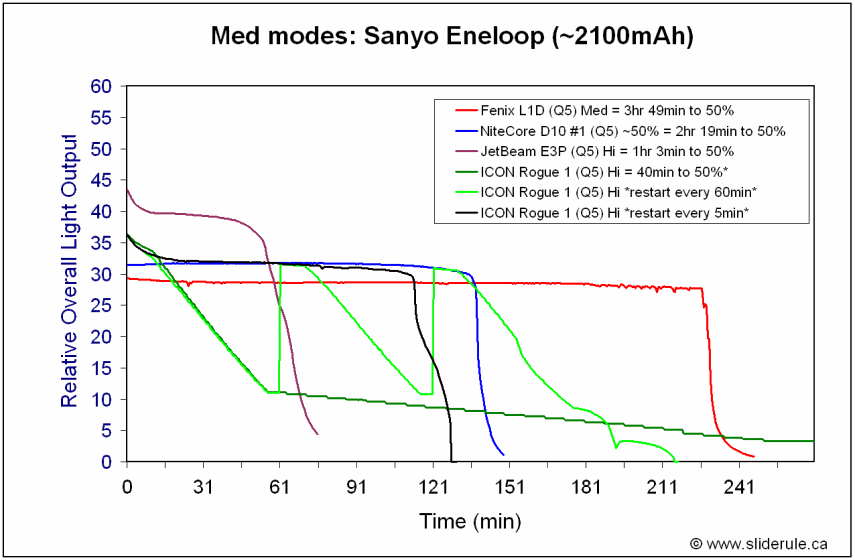
As you can see, it appears that total light output produced by the Rogue 1 on Eneloop (on repeated restart) is roughly similar to what a D10 produces over the course of its continuous run. The Rogue 1 definitely outperforms the JetBeam E3P on Hi. But of course, it comes nowhere near the excellent Fenix L1D.

On alkaline, things look even better for the Rogue 1. Overall output over time appears greater than the D10, and blows away the E3P. oo: Although again, the Rogue 1 fails to match the Fenix L1D.
oo: Although again, the Rogue 1 fails to match the Fenix L1D.

Unfortunately, I only have Hi mode runtime data for the L1D and D10 at the moment. But at least you can tell from the above graph that the Rogue 1 holds its own well on L91.
One last comparison to try … how does the straight-run (i.e. not restarted) Rogue 1 look compared to Lo modes on these competitors?
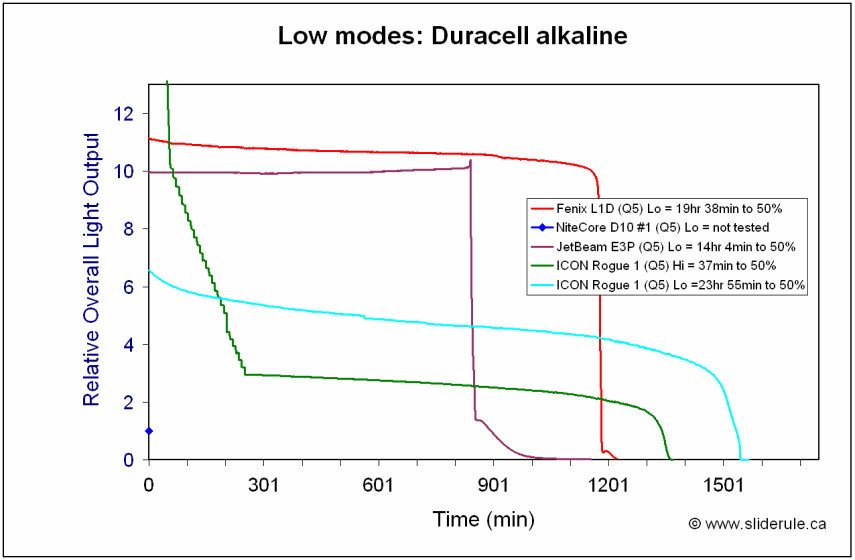
Obviously, the L1D is incredibly efficient at is lowest mode. But the E3P is no slouch either. Given the initial higher output in the first hour of the Rogue on Hi, it really doesn't stand a chance of comparing well on alkaline.
Note that the Lo mode has a constant PWM of 440Hz.
UPDATE 4/2/08: Finally got around to adding the Lo mode runtime on alkaline. Runtime is certainly ok - consistent with what I would expect for a PWM-based light - but it is not as good as a current-controlled light at this output level.
Summary of Output/Runtime Results
The ICON Rogue presents a new type of regulated circuit that I haven't seen before. As these results show, it is tightly regulated – just in a non-traditional fashion. The key point is the 4 defined stages of output on Hi: 10 mins of fairly level Max output, followed by 45.5 mins of rapidly declining output in a stepwise fashion (65 steps down of 1% each), followed by 194.5 mins of slowly stepping down output (25 steps down of 1% each), followed by a long "moon mode" of slowly decaying output until the cell is exhausted. The pattern can be restarted at anytime by simply running through an off/on cycle.
Given the unusual runtime pattern, I thought repeated re-starts made the most sense for comparison purposes. Since it can be hard to compare the graphs directly, I've also done area under curve summation for the various battery conditions.
For this analysis, I've summed the ROV values along the entire length of the run (to zero output), sampling at 1 reading every minute. The total value thus represents to total amount of light produced at this sampling rate. It has no specific meaning, except to show the relative output/runtime efficiency between the different testing conditions.

The results match the visual interpretations I presented above, and allow us to quantify it a little better. When roughly matched for initial output, repeated re-starting of the Rogue 1 on Hi is nearly as efficient overall as a continuous run of the NiteCore D10 on Eneloops, and slightly more efficient than the D10 when both run on alkaline. The Rogue is invariably more efficient than the JetBeam E3P on all batteries. And the Fenix L1D trumps all the other lights on its Med setting.
Oh, and based on a direct comparison to my Novatac 120P, I would estimate the peak lumen output for the Rogue 1 on Hi/Lo to be 60 and 6 lumens. Of course, that only applies if you trust the calibration of the Novatac ....
Potential Issues
The ICON Rogue is the largest 1xAA light in my collection – and is thus likely too bulky for EDC use for most people. It is also toward the heavier range, but is typically still lighter than traditionally-sized 1xAA lights in stainless steel.
The raised flats have the potential to pinch skin or clothing when carried, although you could modify to minimize this (i.e. wrap in paracord). At a minimum, these stylistic touches are likely to attract dirt and debris.
The novel regulation pattern is unlikely to find favour with many flashaholics here on CPF, since it does not provide a constant level of light output (see below for a preliminary discussion).
Light uses noticeable PWM of 140 Hz for the stepping-down phase on Hi (starting at 10 mins into the run).
Preliminary Observations
I could blather on here about the unique build of the light - with its unusual raised body tube flats and large heavily-textured reflector – but the truth is that the circuit performance is what makes this light unique.
I don't know what ICON intended with this stepping down pattern. But given the exacting level of control excised, I think we can safely assume it is more than just a cheap way to limit output for thermal concerns, or to act as a "nanny" for users who inadvertently leave their lights on. If that's all they wanted to do, they could have simply shut the light off after a defined time, or let it decay rapidly through less controlled means.
Instead, they choose strict output and time control of the light. Whether or not you like this regulation pattern, you have to admit it is pretty unique. It could not have been easy for them to deliver a circuit that can produce visually-linear decreases of 1% reliably, over the entire course of a run, at precisely-controlled time intervals – and on all battery chemistries to boot!
UPDATE: Apparently, this sort of circuit is much easier to create than I originally thought. See posts by HKJ below - basically, it could be done with a fairly simple table of voltage settings for each output step.
Note that 1% drops in output are not noticeable in general use, and even at the "fast" rate of one step down every 43 secs, it will take awhile before you notice the drop. Your eye will adjust as the level drops, and I suspect you wouldn't even notice the brightness has dropped until you are approaching stage 3 (i.e. 65% reduction in output). I rather doubt this is an accident – they presumably went for just this rate of reduction to avoid perception of output loss.
– they presumably went for just this rate of reduction to avoid perception of output loss.
The question is why? Your guess is as good as mine – and I welcome your suggestions as to how this pattern could be useful in real life. :shrug:
As intrigued as I may be with the circuit performance, one thing that does not impress is the visibly-noticeable PWM of 140 Hz. :thumbsdow Truthfully, 2007 was the last time I reviewed a new light with visible PWM flicker. If NiteCore, JetBeam, Lumapower, LiteFlux, ITP, et al can all produce well-regulated lights with undetectable PWM levels for over a year now, why can't ICON? Maybe the precise stepping pattern requires a lower PWM to function reliably, or with acceptable efficiency. But if so, this again begs the question of why have such precise control in the first place? :thinking:
Perhaps this circuit is a forerunner for a more sophisticated model with additional features and controls? The ability to step down at consistent visually-linear outputs would be very useful for a simplified continuously-variable light, for example ….
Hopefully the answer to these riddles will be revealed in time. I welcome your thoughts as to whether the unique circuit performance is useful for you, or what it all might mean.
Warning: Pic heavy!
ICON is a new name on the flashlight scene, but the source behind it is well known: a spin-off from Surefire, ICON will be supplying new entry-level consumer lights that run on standard batteries.
First out of the gate are the Rogues, straightforward two-stage lights that run on 1xAA and 2xAA. Designed by legendary Surefire designer Paul Kim, these lights feature an innovative circuit and unusual body build. Reviewed below is the 1xAA version, but many of the features are common to both.
A word up front: don't expect typical Surefire quality or level of support with these lights. :tinfoil: On the plus side, price will also be commensurate with their entry level status: I believe MSRP will be under $40 for the Rogue 1, although early limited release samples in Asia ran for typically ~$70.
Certainly snazzy packaging. I opted for the gray model, but green and black are also available. As identified on the back, note that these are designed in the U.S. but made in China.
Inside you will find the light and very high quality wrist lanyard (with additional quick-release neck lanyard). :thumbsup: The instructions are included on the inside of the cardboard insert.
One thing that caught my eye – the warranty info for ICON is limited to a single year:
The light itself is most unusual. Much larger than typical 1xAA lights, the Rogue 1 has a unique look and design. Here is a size comparison to other 1xAA lights and a couple of classic Surefires:
The light is not as heavy as you might think from first appearances, as three of the body tube flats are raised from the battery tube core.
Rogue 1 Weight: 85.6g
Rogue 1 Length: 114.0 mm
Rogue 1 Width: 27.7mm
For the record, most of the aluminium 1xAA lights shown above are in the 40-55g range, with the stainless steel lights in the 90-105g range.
As an aside, when I first showed it to Mrs Selfbuilt, her initial impression was "wow, that's a solid looking light". When she went to pick it up, she was surprised by the relatively low weight for its apparent size – presumably explained by the hollow flats around the battery tube. Subsequent comments about those raised flats involved a few less-than-flattering references to potato peelers and cheese graters (rest assured they aren't that sharp).
EDIT: I may have to revise that statement - check out a little good natured ribbing in post #17.
Seriously, the raised flats do serve as a lanyard attachement point. There is no lanyard loop or ring. From the instructions:
The head unscrews from the body tube, which is the only way to access the interior (the tailcap is continuous with the body tube, and is not obviously accessible). The light came with an Energizer AA battery inside, as shown. Screw threads are anodized, allowing for a head-body lockout. The overall mating appearance is similar to Surefire E-series lights, but of course these components are not E-series compatible.
The tailcap is a forward clicky, with a large surrounding button cover. You can activate the light and switch modes in tactical momentary fashion. The light cannot tailstand.
The head unit of this light is quite large by 1xAA standards. The light uses the common Cree Q5 emitter.
First thing you might notice is the rather heavy texturing to the OP reflector – this is much stronger than most other lights.
 A second point is that the emitter is clearly somewhat off-center on my sample. As you will see below, this doesn't cause a problem for the beam (likely due to the heavy reflector texturing).
A second point is that the emitter is clearly somewhat off-center on my sample. As you will see below, this doesn't cause a problem for the beam (likely due to the heavy reflector texturing).I haven't opened the head up yet, but I believe both the reflector and lens are made of plastic. While this is bound to disappoint some, I've found in my testing that well-designed and well-made plastic reflectors can still perform just as well aluminium ones. :shrug: Scroll down for beamshots.
User Interface
The UI is in keeping with the KISS principle – click on once for Hi, click off and back on within a short period of time for Lo. Click again to turn off. Basically the same as the Surefire E1B Backup. :kiss:
Comparison Beamshots
All lights are on 100% on Sanyo Eneloop. Distance is about 0.5 meters from a white wall.
1/25sec, f3.2

1/100sec, f3.2

1/800sec, f3.2

First thing you will note is the somewhat wider spillbeam compared to most lights. It is also clearly not much of a thrower.
But one thing I haven't heard in online discussions of this light is how pretty the beam looks – it's incredibly smooth and even, with a nice corona with little evidence of rings. :twothumbs Considering the mis-centered emitter on my sample, that's very impressive. Overall, I would say the beam is very SSC-like (reminds me a bit of my Novatac 120P). Tint is a pleasing slightly warm "cool white" on my sample.
Testing Method: All my output numbers are relative for my home-made light box setup, a la Quickbeam's flashlightreviews.com method. You can directly compare all my relative output values from different reviews - i.e. an output value of "10" in one graph is the same as "10" in another. All runtimes are done under a cooling fan..
Throw values are the square-root of lux measurements taken at 1 meter from the lens, using a light meter.
Throw/Output Summary Chart:
As you can see, the ICON Rogue does not have a strong initial output or throw on Hi on standard batteries. Until this light came out, the JetBeam E3P had the lowest Hi mode of any of my Cree Q5 lights. The Rogue 1 Lo mode is a very useful and respectable level – lower than the Fenix, but not ultra-low like the D10.
But this is just the tip of the iceberg – the real interest is in the runtime plots.
Output/Runtime Comparison:
To begin, here is a sample of what a "typical" well-regulated PWM-based light looks like on different battery types:

As you can see, Max output varies with battery type, as does the runtime pattern. This is consistent with being optimized for different battery chemistries. In general terms, most "regulated" lights that we are familiar with are regulated to as flat a level as possible, for as long as possible, on all supported battery sources.
Here's how the ICON Rogue 1 looks:
So what is going on here? :thinking: Basically, the Rogue regulates all battery types to the same general pattern and output on continuous running. Naturally, what will differ is how long the lights will run – that depends on the total capacity available in the battery.
This is quite novel in itself – but even more interesting is that actual pattern the lights are regulated to. The Rogue has 4 defined stages, each with its own characteristics. To illustrate how they work, here are some higher-resolution plots of the Stage 1-2 transition and Stage 2-3 transition time points:
In Stage 1, the light runs on a fairly typical regulated pattern - relatively flat, but with a slow decay. This stage lasts for exactly 10mins of continuous running, with no perceptible PWM.
Stage 2 is a relatively rapid stepping down of output. At this point, PWM is detectable at a constant 140 Hz. Each step is almost exactly 0.3 on my relative output scale (ROV) - which given the initial output of just over 30 ROV, translates into a ~1% reduction. Each step lasts for ~43 secs. There are 65 such steps in this stage, thus taking an additional ~45.5 mins to complete.
Note that these steps remain visually-linear at 1% all along the way.
Stage 3 is a lengthening of the step interval time, with no change to the magnitude of the step down or the PWM frequency. The light is now at ~35% initial output, and continues to step down in ~1% visually-linear increments - but the duration of each step is increased to ~467 secs.
This stage continues for 25 such steps, thus taking an additional ~194.5 mins. Stage 4 is not shown, but this appears to be a gradual dimming of the light over long period of time, depending on the battery source. Relative light output at the start of Stage 4 is ~10% of maximum.
Whatever you may think of this pattern, it is a quite novel – to step-down in a visually-linear manner, with such tightly-controlled timings, is not something I've seen before. :thinking: I'll discuss the possible significance of this later in the review.
Note that you can return to start of the pattern by simply turning the light off and back on again. No lag time is needed – just off and on.
This is advantageous is real use – but also for my comparison purposes here. It is hard to compare this rapid drop-off pattern to other lights that use a more traditional burn-bright-until-dead approach to regulation. To get around this, I've decide to compare the runtimes of the Rogue with a repeated on/off switch at 1 hour intervals (to restore max output).
Now this is interesting. On NiMH or L91, the Rogue is able to pretty much directly repeat the initial output/runtime pattern upon restart. On alkaline, it still produces the same timings, but at a lower initial output.
What I found surprising here is that 2000mAh rated Eneloops do not appear to produce significantly more overall output/runtime than a standard alkaline cell. :huh: Typically, NiMH is much closer to L91 lithiums in terms of storage capacity and output/runtime ability. Based on these early results, it appears that the Rogue is probably designed for best efficiency on primary cells (alkaline and L91) rather than NiMH.
So how does this compare to the competition?
Obviously, the L1D and D10 are capable of much brighter max output. So this comparison doesn't tell us much - remember, lights are more efficient at lower drive currents. As such, I think comparing the Rogue 1 to L1D/D10 on Medium/50% modes makes more sense:
As you can see, it appears that total light output produced by the Rogue 1 on Eneloop (on repeated restart) is roughly similar to what a D10 produces over the course of its continuous run. The Rogue 1 definitely outperforms the JetBeam E3P on Hi. But of course, it comes nowhere near the excellent Fenix L1D.
On alkaline, things look even better for the Rogue 1. Overall output over time appears greater than the D10, and blows away the E3P.
Unfortunately, I only have Hi mode runtime data for the L1D and D10 at the moment. But at least you can tell from the above graph that the Rogue 1 holds its own well on L91.
One last comparison to try … how does the straight-run (i.e. not restarted) Rogue 1 look compared to Lo modes on these competitors?
Obviously, the L1D is incredibly efficient at is lowest mode. But the E3P is no slouch either. Given the initial higher output in the first hour of the Rogue on Hi, it really doesn't stand a chance of comparing well on alkaline.
Note that the Lo mode has a constant PWM of 440Hz.
UPDATE 4/2/08: Finally got around to adding the Lo mode runtime on alkaline. Runtime is certainly ok - consistent with what I would expect for a PWM-based light - but it is not as good as a current-controlled light at this output level.
Summary of Output/Runtime Results
The ICON Rogue presents a new type of regulated circuit that I haven't seen before. As these results show, it is tightly regulated – just in a non-traditional fashion. The key point is the 4 defined stages of output on Hi: 10 mins of fairly level Max output, followed by 45.5 mins of rapidly declining output in a stepwise fashion (65 steps down of 1% each), followed by 194.5 mins of slowly stepping down output (25 steps down of 1% each), followed by a long "moon mode" of slowly decaying output until the cell is exhausted. The pattern can be restarted at anytime by simply running through an off/on cycle.
Given the unusual runtime pattern, I thought repeated re-starts made the most sense for comparison purposes. Since it can be hard to compare the graphs directly, I've also done area under curve summation for the various battery conditions.
For this analysis, I've summed the ROV values along the entire length of the run (to zero output), sampling at 1 reading every minute. The total value thus represents to total amount of light produced at this sampling rate. It has no specific meaning, except to show the relative output/runtime efficiency between the different testing conditions.
The results match the visual interpretations I presented above, and allow us to quantify it a little better. When roughly matched for initial output, repeated re-starting of the Rogue 1 on Hi is nearly as efficient overall as a continuous run of the NiteCore D10 on Eneloops, and slightly more efficient than the D10 when both run on alkaline. The Rogue is invariably more efficient than the JetBeam E3P on all batteries. And the Fenix L1D trumps all the other lights on its Med setting.
Oh, and based on a direct comparison to my Novatac 120P, I would estimate the peak lumen output for the Rogue 1 on Hi/Lo to be 60 and 6 lumens. Of course, that only applies if you trust the calibration of the Novatac ....
Potential Issues
The ICON Rogue is the largest 1xAA light in my collection – and is thus likely too bulky for EDC use for most people. It is also toward the heavier range, but is typically still lighter than traditionally-sized 1xAA lights in stainless steel.
The raised flats have the potential to pinch skin or clothing when carried, although you could modify to minimize this (i.e. wrap in paracord). At a minimum, these stylistic touches are likely to attract dirt and debris.
The novel regulation pattern is unlikely to find favour with many flashaholics here on CPF, since it does not provide a constant level of light output (see below for a preliminary discussion).
Light uses noticeable PWM of 140 Hz for the stepping-down phase on Hi (starting at 10 mins into the run).
Preliminary Observations
I could blather on here about the unique build of the light - with its unusual raised body tube flats and large heavily-textured reflector – but the truth is that the circuit performance is what makes this light unique.
I don't know what ICON intended with this stepping down pattern. But given the exacting level of control excised, I think we can safely assume it is more than just a cheap way to limit output for thermal concerns, or to act as a "nanny" for users who inadvertently leave their lights on. If that's all they wanted to do, they could have simply shut the light off after a defined time, or let it decay rapidly through less controlled means.
Instead, they choose strict output and time control of the light. Whether or not you like this regulation pattern, you have to admit it is pretty unique. It could not have been easy for them to deliver a circuit that can produce visually-linear decreases of 1% reliably, over the entire course of a run, at precisely-controlled time intervals – and on all battery chemistries to boot!
UPDATE: Apparently, this sort of circuit is much easier to create than I originally thought. See posts by HKJ below - basically, it could be done with a fairly simple table of voltage settings for each output step.
Note that 1% drops in output are not noticeable in general use, and even at the "fast" rate of one step down every 43 secs, it will take awhile before you notice the drop. Your eye will adjust as the level drops, and I suspect you wouldn't even notice the brightness has dropped until you are approaching stage 3 (i.e. 65% reduction in output). I rather doubt this is an accident
The question is why? Your guess is as good as mine – and I welcome your suggestions as to how this pattern could be useful in real life. :shrug:
As intrigued as I may be with the circuit performance, one thing that does not impress is the visibly-noticeable PWM of 140 Hz. :thumbsdow Truthfully, 2007 was the last time I reviewed a new light with visible PWM flicker. If NiteCore, JetBeam, Lumapower, LiteFlux, ITP, et al can all produce well-regulated lights with undetectable PWM levels for over a year now, why can't ICON? Maybe the precise stepping pattern requires a lower PWM to function reliably, or with acceptable efficiency. But if so, this again begs the question of why have such precise control in the first place? :thinking:
Perhaps this circuit is a forerunner for a more sophisticated model with additional features and controls? The ability to step down at consistent visually-linear outputs would be very useful for a simplified continuously-variable light, for example ….

Hopefully the answer to these riddles will be revealed in time. I welcome your thoughts as to whether the unique circuit performance is useful for you, or what it all might mean.
Last edited:


